Traditional Scottish Shortbread
This post may contain affiliate links. See my disclosure policy.
This traditional Scottish Shortbread recipe creates those perfectly crumbly, irresistibly buttery, and wonderfully delicious shortbread biscuits that have been a year-round favorite treat for centuries. It’s made with just 3 staple ingredients but the flavor and texture is unforgettable!
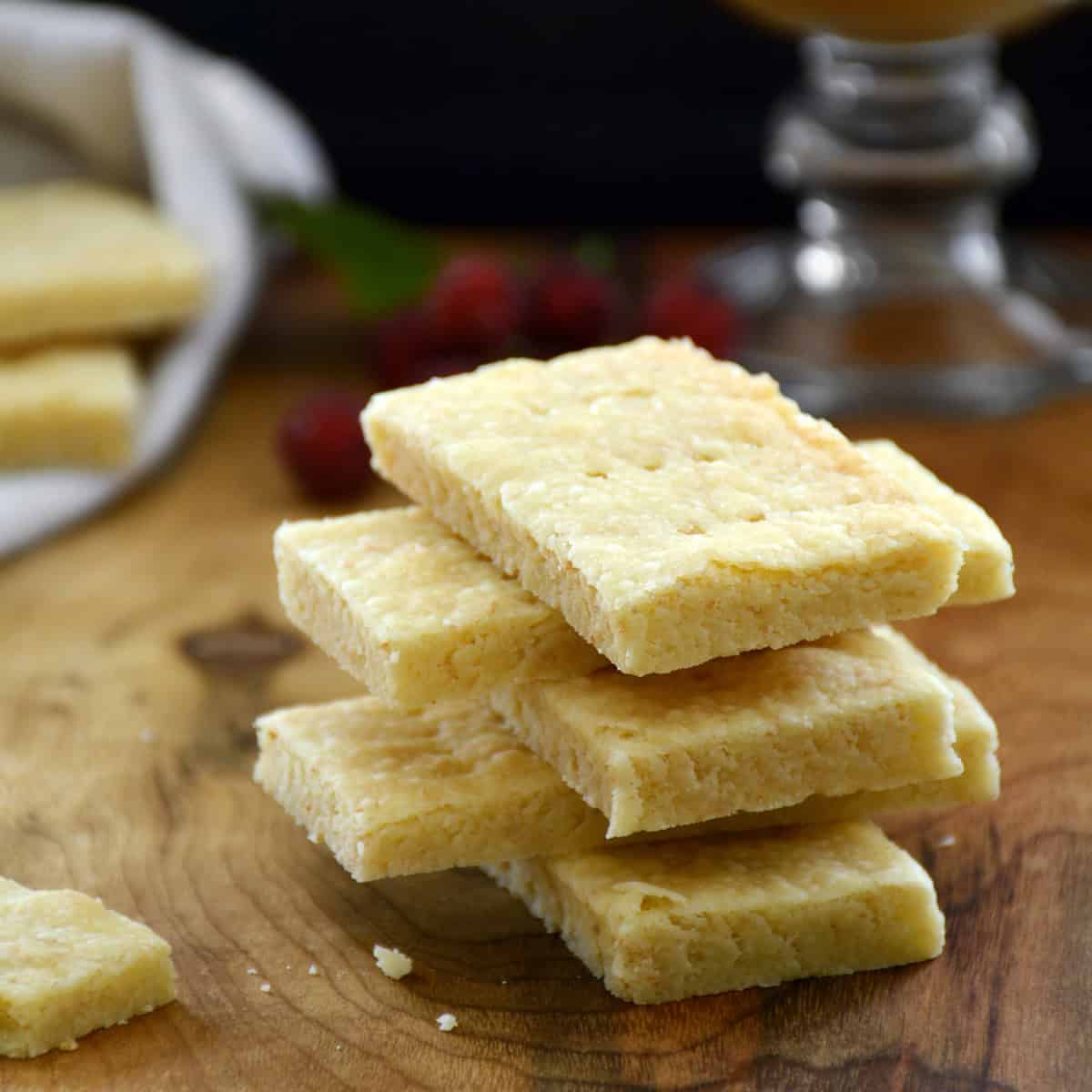
What is Shortbread?
Shortbread is as basic and simple as a cookie (biscuit) can get. But it’s also divinely delicious. And for that reason shortbread has been a favorite throughout the UK for hundreds of years.
The origin of shortbread goes back to somewhere around the 12th century when it was originally made from leftover bread-making dough that was left to dry out and harden into “biscuit bread.” Over time butter replaced the yeast and biscuit bread evolved into shortbread. The term “short” refers to the crumbly texture from the large quantity of butter. Butter was a luxury item and so shortbread was enjoyed only on special occasions and, of course, by the nobles and royals.

The more refined version of shortbread as we know it today is attributed to Scotland, in particular to Mary, Queen of Scots in the 16th century. She was particularly fond of what was known as Petticoat Tails, which was a thin shortbread baked in a large circle and cut into triangular segments. In her day the shortbread was commonly flavored with caraway seeds, which were all the rage in British baking for several centuries. In fact, the earliest published shortbread recipes from the 18th century were more elaborate than the standard shortbread today: They were baked with candied citrus peels and garnished with caraway comfits.
Traditionally Scottish shortbread is baked in either a rectangular or square slab and cut into fingers, as individual round biscuits, or in one large circle and cut into triangles. But you can cut them any shape you like and also use cookie stamps. I have these cookie stamps, these ones, and these ones and love them all – excellent quality.
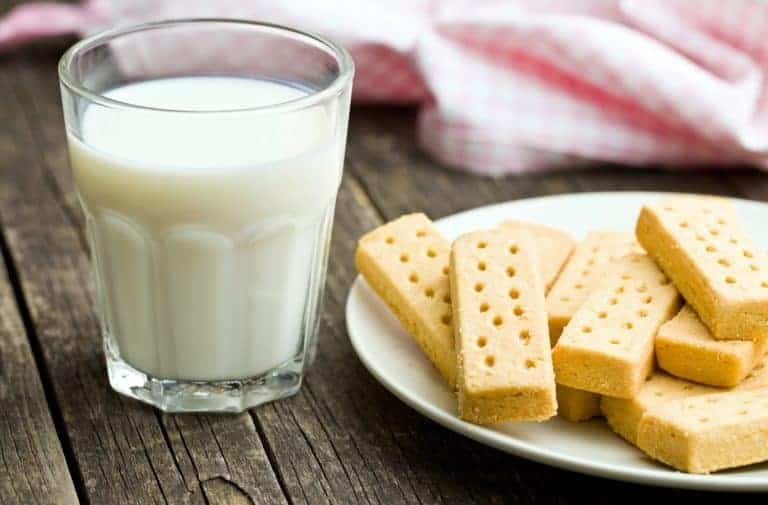
Scottish Shortbread Ingredients
We’re making Scottish shortbread the traditional way with just 3 ingredients: Flour, Sugar and Butter. Well, and a tiny pinch of salt, too. Nothing else is needed, no fancy ingredients, no flavor enhancers. The key to a good Scottish shortbread is the quality of the butter. That is what flavors the shortbread and the shortbread is only as good as the butter.
I’ve read a few claims that “traditional” Scottish shortbread is made with farola, which is a fine flour milled from durum wheat. But the oldest recipes I’ve researched do not, so this “tradition” may be a later/more contemporary one. Likewise some recipes call for powdered/confectioner’s sugar as well as rice flour; neither of these are traditional and should be avoided if you’re goal is to make authentic Scottish shortbread.
Another key to making Scottish shortbread is to use caster sugar. Not regular granulated sugar. Not powdered/confectioner’s sugar. Caster sugar is very fine granulated sugar. Caster sugar is commonly used in British baking and it’s an all-around smarter choice than granulated. The reason is that the sugar crystals in granulated sugar are much larger and take longer to dissolve during baking and may not dissolve completely. Caster sugar dissolves more rapidly leaving a finer texture to the baked good. You can buy caster sugar in the store or very simply make your own buy pulsing granulated sugar in a food processor or blender until it is ground more finely.

Scottish Shortbread Variations
In addition to the three base ingredients of flour, sugar and butter, there are a number of add-ins you can include to flavor your shortbread. Classic options include candied ginger, candied orange peel, dried cranberries or cherries, nuts, chocolate chunks, rosemary, lavender, and you can also dip or drizzle the shortbread biscuits with chocolate.

This Scottish Shortbread recipe is very simple and very easy to make and once you’ve made it yourself there will be no need to buy it again! Before we get started, if you want to take your shortbread to the next several flavor levels, try my traditional Scottish Millionaire’s Shortbread. With layers of shortbread, caramel and chocolate it is the ultimate indulgence! (Incidentally, it’s what my son requests every year for his birthday!)
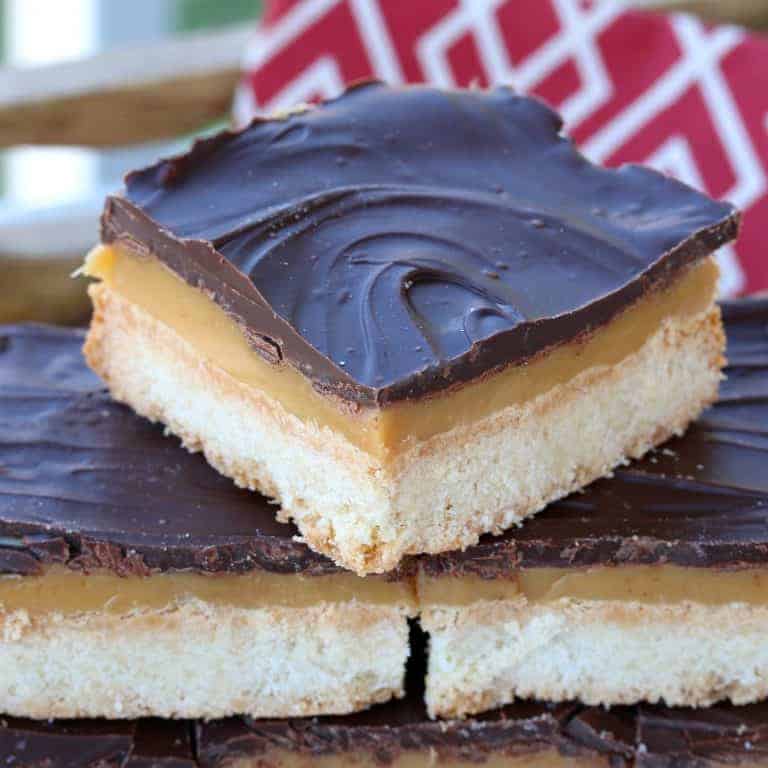
Scottish Shortbread Recipe
Let’s get started!
You can either buy caster sugar (it’s overpriced) or make you’re own, which is what I do. Super easy: Just put the sugar in a blender or coffee/spice grinder and pulse until it’s very fine.
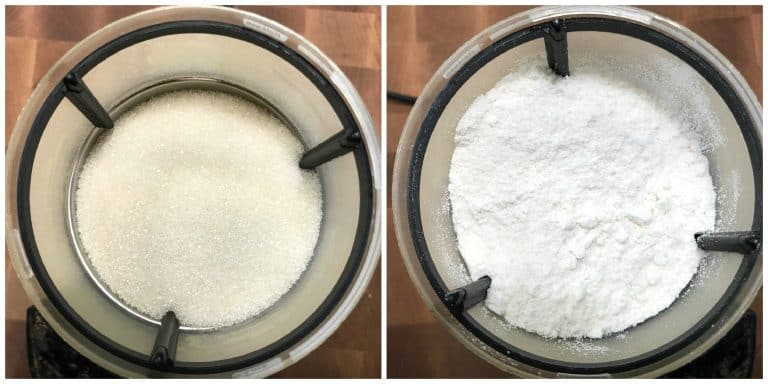
Place the flour, butter, caster sugar and salt in a food processor and pulse until it’s combined and looks like coarse breadcrumbs but is soft and pliable and comes together in a dough when you press it together between your fingers. If it’s too dry and crumbly it needs to be pulsed a bit longer.
At this point stir in any add-ins if using (candied ginger, candied citrus peel, herbs, nuts, etc.)
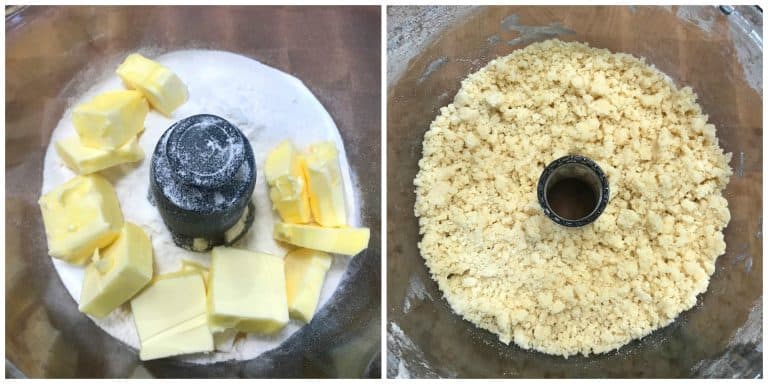
Pour the mixture into a greased 8×8 inch (shortbread roughly 3/4 inch thick) or a 9×9 inch (shortbread about 1/2 inch thick) baking pan. You can also use a round cake pan. Use your fingers and hands to firmly press down the mixture.
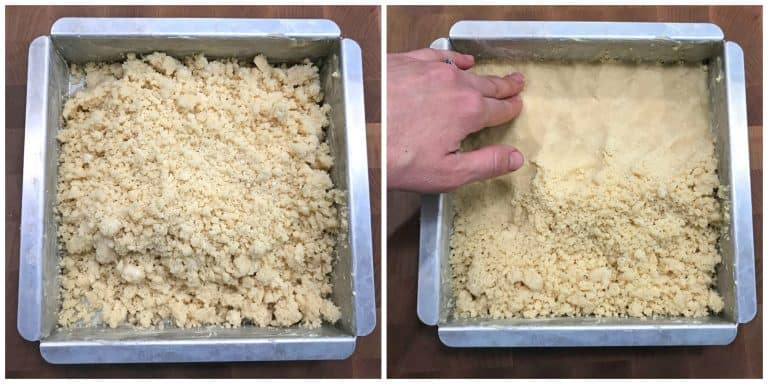
Prick the shortbread with the tines of a fork, creating rows. You can also run a knife between each row of fork tines to make cutting the shortbread easier after it’s baked. Another option is to prick the shortbread with a fork immediately after it is done baking while it is still warm; this way the holes will be more pronounced as they have a tendency to close during baking.
Preheat the oven to 350 degrees F. Place the shortbread on the middle rack and bake for 30-35 minutes or until light golden and firm. Remove from oven and sprinkle lightly with caster sugar or granulated sugar. Let cool. Cut and serve.
Store the shortbread in an airtight container for up to several weeks. Its flavor and texture improves over time.
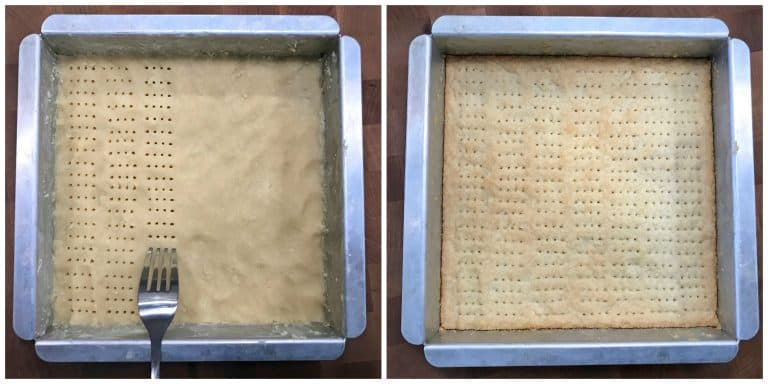
Storage Tips
Shortbread has a low moisture content and so it does best when it’s stored in an airtight container. Cool, dry conditions are optimal to enable the shortbread to retain some crisp without becoming stale. Stored this way it will keep for a few weeks. If you plan on keeping it longer it can also be frozen. To do that, place some parchment paper between the shortbread biscuits to prevent them from sticking to each other. Freeze them in freezer containers or ziplock freezer bags and let them thaw at room temp when you’re ready to eat them. They can be frozen for up to 3 months.
Enjoy!
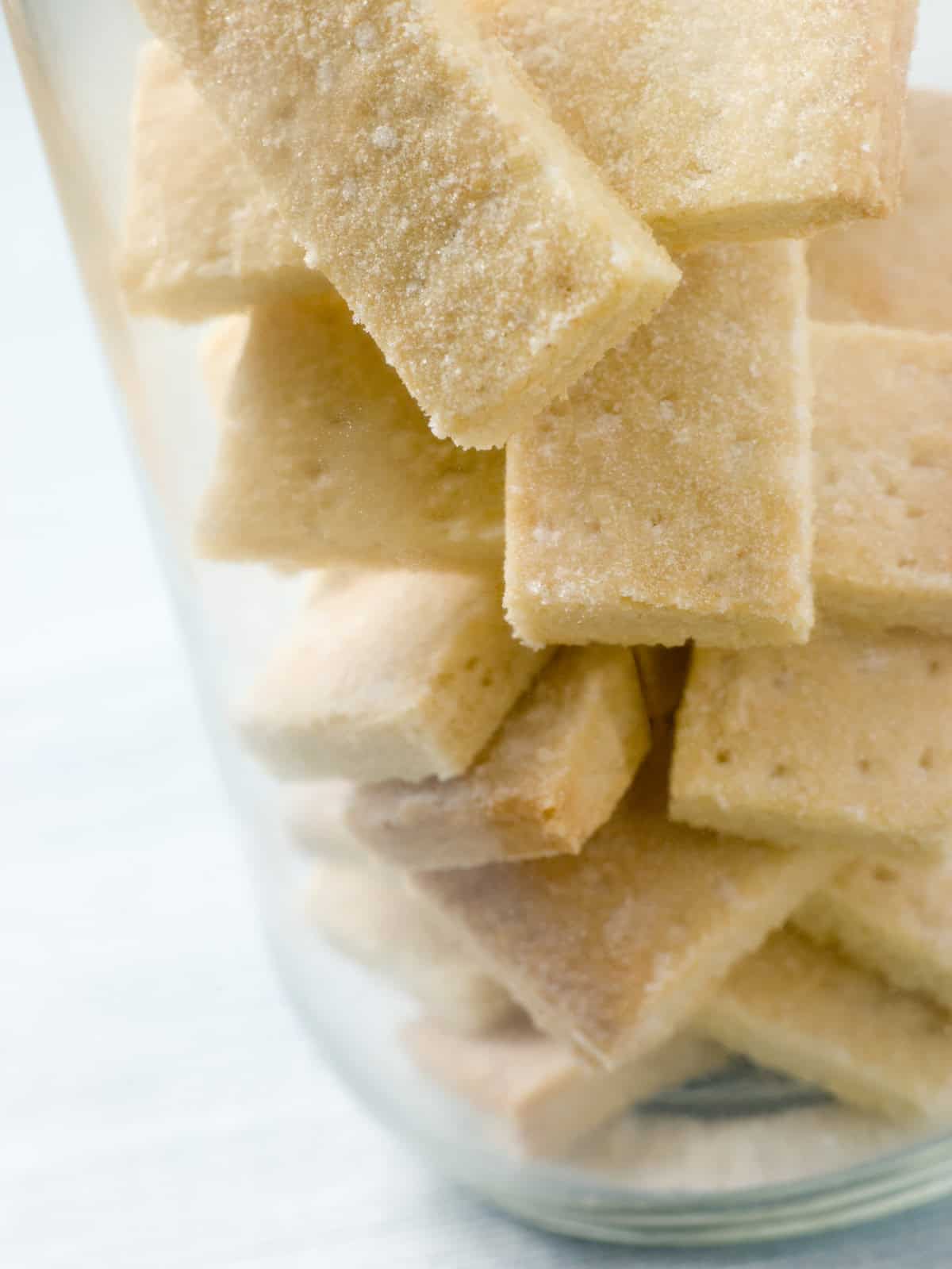
For more traditional British treats try my:
- Treacle Tart
- Sticky Toffee Pudding
- Spotted Dick
- Chelsea Buns
- Lardy Cake
- Eccles Cakes
- Chelsea Buns
- Cornish Fairings
- Hot Cross Buns
- Easter Biscuits
- Parkin
- Bara Brith
- Barmbrack
- Mincemeat
- Mince Pies
- Victoria Sponge Cake
Save This Recipe
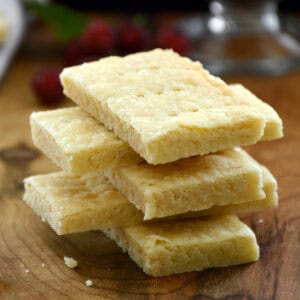
Traditional Scottish Shortbread
Equipment
- Cookie stamps (optional)
Ingredients
- 2 1/2 cups all-purpose flour
- 1 cup quality unsalted butter , cubed and softened at room temperature (the better the butter, the better the shortbread)
- 1/2 cup caster sugar , or "baker's sugar" in the U.S. (if you can't find it simply pulse granulated sugar in a blender until very fine. Do NOT use powdered sugar)
- 1/2 teaspoon salt
- Optional Add-Ins:
- Homemade Candied Ginger (click link for recipe)
- Homemade Candied Citrus Peel (click link for recipe)
- Other options include nuts, fresh herbs, dried cranberries, etc.
Instructions
- Preheat the oven to 350 degrees F. Butter a 8×8 or 9×9 inch square baking pan. You can also use a round cake can and cut the shortbread into triangles.
- Place the flour, butter, caster sugar and salt in a food processor and pulse until it's combined and looks like coarse breadcrumbs but is soft and pliable and comes together in a dough when you press it together between your fingers. If it's too dry and crumbly it needs to be pulsed a bit longer. (If using any add-ins, stir them in at this point.)Pour the mixture into the greased baking pan. Use your fingers and hands to firmly press down the mixture. Note: If the mixture is too dry to work with, including pricking with a fork (see below), then it was not pulsed long enough in the food processor. Prick the shortbread with the tines of a fork, creating rows. You can also like run a knife between each row of fork tines to make cutting the shortbread easier after it's baked. Another option is to prick the shortbread with a fork immediately after it is done baking while it is still warm; this way the holes will be more pronounced as they have a tendency to close during baking.
- Place the shortbread on the middle rack and bake for 30-35 minutes or until light golden and firm. Remove from the oven and sprinkle lightly with caster sugar or granulated sugar. Let cool. Cut and serve.Store the shortbread in an airtight container in a cool place (not the fridge) for up to several weeks. Its flavor and texture improves over time.
Nutrition
Originally published on The Daring Gourmet March 10, 2019



















No, to the recipe
The shortbread are totally mishaped. The dough just melted and the butter was running out the form. I followed the recipe. Had to refrigerate for 30 min before putting in the oven and still it is not good and not fully cooked even after 1 & 1/2 hrs of baking
And it’s not the first time I made shortbread, just wanted to try yours.It was just waste of time.
Hi Kimberly
My shortbread are totally mishaped. The dough just melted and the butter was running out the form. I followed the recipe. And it’s not the first time I made shortbread, just wanted to try yours. So no give aways for my boys, waste of time and money. Just sad.
Do I need to add baking powder to the recipe, or just use the all purpose (or plain flour)?
Hi Lyn, no baking powder, just flour. There are no “rising” agents in shortbread.
Thanks for your help Kimberly, I will get baking :)
As a writer, I believe ingredients are not subject to copyright in s recipe, only method (instructions) Correct me if I’m wrong please. Thank you.
That’s correct, Alastair. And of course photos are likewise subject to copyright in addition to the recipe instructions.
Hi I love this recipe and wonder if I might have permission to put it in my newsletter? I am a Historical Romance author and would like to share it with my subscribers. If you agree how would you like me to credit you for the original recipe?
Hi Tammy, you can use the photo credited to The Daring Gourmet with a link to the recipe on my site but I would ask that you not post the recipe in full. Thank you for understanding and thank you for sharing my site with your readers.
I made these today and the are excellent. My grandparents were Scottish and Welsh, and sadly, I no longer have my grandmothers recipe for her “Lorna Doone” shortbread cookies. These cookies are as close as it gets. Delicious. Too many recipes call for things like vanilla or almond extract, but I loved this one because it’s got a true buttery flavor. I ground my granulated sugar in the food processor, and used unsalted butter. My food processor is only a 3 cup, so I processed the dough in two batches and mixed them together. I used a sheet of saran wrap on top of the dough to press it into the pan nice neat. I took great pains to get the fork-holes nice and even, but in the end it didn’t matter, as they all closed up in baking! Possibly because it’s a hot day and my butter was really quite soft. But no one would notice but me. Highly recommend this recipe. Thank you for posting!
Thank you, Moxie, I’m so glad you enjoyed them and appreciate the feedback!
I love Walkers shortbread but this recipe is divine!!! I made as directed, ground up my own sugar, processed long enough & had no problems poking the top or cutting when cooled. Thank you for this simple, delicious, amazing recipe!!! I did melt chocolate on top, so good! I can’t wait to try the Millionaire shortbread. That will be lethal😉
Awesome, Kari, thank you! Lethal is the perfect word for it, haha – dangerous but SO good! :)
You add NOTHING to shortbread…if you put anything else in, it’s just a ‘cookie”…
I think Scotland’s most famous shortbread manufacturer, Walkers, would beg to differ, Hugh :)
Lose the food processor and knead with your hands. Also, store in a cookie tin in a dark, cool dry place for at least a month. Helps if you live in a cooler climate like Scotland or Canada. Only then does it take on the special texture of authentic shortbread, not just a butter cookie. My mother would have to hide it well but she would start Christmas cooking in October or early November.
Love! Made it for our Scottish themed dinner. (We’ve been having international themed dinners to make things a bit more fun) and not only are they delicious, they are easy!
Used regular butter since we avoid added shopping and your tip for creating superfine (caster sugar) worked well. I did add a few tablespoons of flour to the sugar when I whirred it in the food processor.
Thank you so much for this.
Stay safe and healthy.
I’m so glad you enjoyed it, Linda, thank you! And I love the idea of your themed dinners, so fun! :)
These shortbread cookies are super easy and really delicious. I followed the recipe exactly as written and had no problem with pricking the dough or slicing the cookies. The baked cookies lift out of the pan easily and are tender and delectably crumbly. They are wonderful plain but I may drizzle some melted chocolate over some of them when they’re cool. Eat them with a plate under your chin or the crumbs will be all over you!
For me, the secret was to pulse the ingredients until they just begin to clump together. Then it’s very easy to pack the dough into your pan. If you don’t pulse the dough long enough you’ll have problems.
Thank you, Shary, I’m so glad you enjoyed them! I just made a batch last week to make Millionaire’s Shortbread for my son’s birthday – that is what he requested as his birthday “cake”, he’s obsessed with the stuff :)
As I am waiting this to come out of the oven I discover I have the same problem as several others have had. I tried using a fork to punch the holes in the top but it just pulls the pastry up when I lift the fork. Same with trying to cut with a knife. I’m gonna’ try to cut once it comes out of the oven. The mixture was very crumbly and I had measured all ingredients very carefully. …. It just came out of the oven and cutting and poking holes was easy. Okay, for now just waiting until it cools enough to remove from the baking dish. Looks good~! …. Too crumbly to hold together. I have it back in the oven to see if it will firm up…. At this point I’m thinking the butter needs to be increased… They did firm up when totally cooled…. Tasting… Excellent~! next time I will reduce the sugar and increase the butter and the baking time due to my oven always seems slow. Thank you.
Thank you! I made this recipe yesterday and when I tasted one it brought a tear to my eye because they reminded me of the ones my Scottish mom used to make. It brought back some fond memories of waiting very impatiently for the shortbread to cool enough so we could have some. Thank you again, this will now be a favorite in our house.
That’s wonderful, Gary, I’m so happy to hear that, thank you!
Recipe(s) are wonderful, just what I was hoping to find! (I must say, however, that family photos climbing on gravestones is not so attractive, nor appropriate)
Thank you, Lisa, I hope you enjoy them! (It’s not a gravestone, it’s a monument by the church.)
Kimberly, what if I used brown sugar?
Hi Jeannie, brown sugar is the same as white sugar in terms of the large size sugar granules and will result in a grainier-textured shortbread that doesn’t have the same melt-in-your-mouth texture as powdered/confectioner’s sugar will.